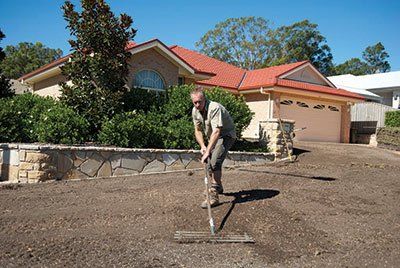You may just need some professional advice on what you need to do before laying your lawn. Our trained staff at Buchanan Turf & Lee Rowan’s can help you through these initial stages. Tap into our wealth of knowledge and DIY !!
DIY PREPARATION
Just like your house is only as good as its’ foundations, your lawn is only as good as its base. Before laying your lawn you should ensure that your soil base is free of weeds, any old grass, stones and debris. The texture of the soil should be crumbly, so you may need to rotary hoe what’s there if the existing soil is suitable, or add some topsoil if not.
EXCAVATION
Sometimes you will need to excavate and remove some soil, often as part of the landscaping process. For small areas this can be done by hand but for more serious quantities, you can’t beat a machine with a good operator. Always check for pipes and services before doing any excavation.
DRAINAGE & LEVELS
Drainage is an important part of any good lawn. If you have large, or deep areas to fill (more than 100mm) we suggest you use ash. It is light, easy to shovel and provides excellent drainage. It is also cost effective and clean to work with. You can then use Oakhampton soil if wanting to sculpt a rolling style lawn, or to provide a heavier base.
Preparing the area We recommend
ESTABLISHING THE BEST BASE
Lee Rowan’s Lush Lawn Underlay at a depth of 50mm. This premium soil has an Oakhampton base with all the essential nutrients to give your lawn the best start possible. Spread evenly, then rake or screed your area to ensure a smooth surface, allowing approximately 25mm below surrounding paths and drive-ways.
SPECIALISED SOIL ADDITIVES
To ensure your result fertilise your base with a, multi-nutrient fertiliser that has moisture magnets such as Sir Launcher (Available in 3kg bucket covering approximately 100m2, or a 900g bucket covering approximately 30m2). This is particularly effective during the summer months when heat can be a problem. Order some when ordering your turf and it will be delivered at the same time. Simply scatter evenly over the entire area before laying your new lawn.
DIY LAYING
TIMING
It is best to have your turf delivered on the day you intend to lay it, so be sure to have all your preparation done beforehand. Ring us a few days before to place your order. Once cut from the farm, the turf is under stress and will easily dry out, so the sooner it is laid and watered the better.
LAYING
Laying should start with one strip of turf being placed around the perimeter, then proceed along the longest edge. Start laying at the bottom of sloped areas, staggering the joints, a bit like brickwork, so they don’t line up. This prevents drying out and soil erosion caused by heavy rain on sloping ground. If the joints all line up, rain can build up like a small river taking the soil with it.
- Butt the turf closely together avoiding gaps
- Avoid using small pieces, these will dry out quickly.
- Do not stretch the turf.
- Cut the turf with a sharp knife or hedging shears.
- Try not to walk on, or wheel a barrow over newly laid turf, as this can damage the root system and cause undulations in the soil. If necessary, use timber planks or plywood sheets for protection and spreading of the load.
- Water your lawn as soon as it is laid. For large areas, especially on hot days, get someone to start watering or set up a sprinkler whilst the remainder of the laying takes place.
For the best result you should roll your lawn after it is laid, concentrating on the joins to help it from drying out. (This isn’t necessarily done in most cases and your lawn will still flourish as long as it is watered well in the first two weeks.) Try not to use your new lawn in the first 2-3 weeks until its’ roots have established themselves.



